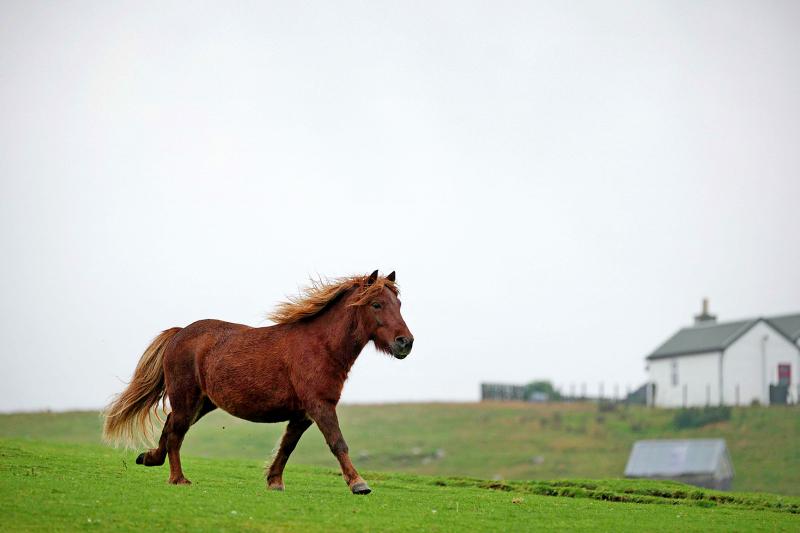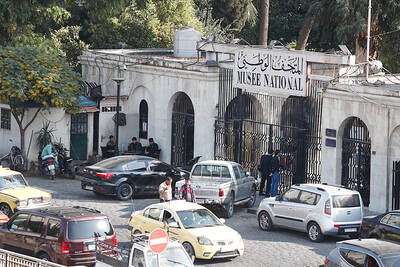In films and literature they are usually depicted as hulking, foot-stomping, snorting beasts, but a new study says the medieval warhorse was typically a much slighter, daintier animal.
A team of archeologists and historians searching for the truth about the steeds that carried knights into battle has concluded that most were probably only the size of a modern-day pony.
The researchers examined the bones of about 2,000 horses dating from the fourth to 17th centuries found at castles, a medieval horse cemetery and other archeological sites in England, as well as combing historical records and fictional stories of chivalry.

Photo: AFP
“It turns out that things are not quite as they have usually been portrayed,” University of Exeter professor of archeological science Alan Outram said. “In popular culture, warhorses are often depicted as the size of a shire horse. It really wasn’t like that. Most medieval horses are surprisingly small. There are very few that are the sort of size portrayed in film or even in exhibitions.”
Outram said the vast majority of medieval horses, including ones believed to have been used in war, were less than 14.2 hands (1.44m) high, the maximum height of a modern pony.
One of the biggest they found was a horse from the Norman period, the remains of which were discovered in the grounds of Trowbridge castle in Wiltshire, but it was only 15 hands — the size of a small modern light riding horse.
Size clearly was not the be-all and end-all for medieval warriors, Outram said.
There might well have been some particularly large warhorses, but armies would also have needed smaller horses for tasks such as harrying a retreating enemy, carrying out long-range raids and transporting equipment, he added.
The research team was keen to spell out they did not mean to imply that medieval horse breeders did not put huge amounts of time, effort and money into their work.
“In the 13th and 14th century especially the royal stud was an amazing network,” Outram said. “They were spending much more money on horses than people.”
There is still much work to do. The remains of very few, if any, horses have been found on battlefields, so working out which animal was a warhorse rather than, say, a farm horse, is difficult.
The team is also hampered by the fact that most fallen warhorses were hauled off to the knacker’s yard rather than afforded an organized burial.
The next steps include analyzing findings at a site in Westminster, more study of horse armor and examining the DNA of bones to find out more about one of history’s most iconic creatures.

Philippine President Ferdinand Marcos Jr yesterday vowed that those behind bogus flood control projects would be arrested before Christmas, days after deadly back-to-back typhoons left swathes of the country underwater. Scores of construction firm owners, government officials and lawmakers — including Marcos’ cousin congressman — have been accused of pocketing funds for substandard or so-called “ghost” infrastructure projects. The Philippine Department of Finance has estimated the nation’s economy lost up to 118.5 billion pesos (US$2 billion) since 2023 due to corruption in flood control projects. Criminal cases against most of the people implicated are nearly complete, Marcos told reporters. “We don’t file cases for

Ecuadorans are today to vote on whether to allow the return of foreign military bases and the drafting of a new constitution that could give the country’s president more power. Voters are to decide on the presence of foreign military bases, which have been banned on Ecuadoran soil since 2008. A “yes” vote would likely bring the return of the US military to the Manta air base on the Pacific coast — once a hub for US anti-drug operations. Other questions concern ending public funding for political parties, reducing the number of lawmakers and creating an elected body that would

A feud has broken out between the top leaders of the far-right Alternative for Germany (AfD) party on whether to maintain close ties with Russia. The AfD leader Alice Weidel this week slammed planned visits to Russia by some party lawmakers, while coleader Tino Chrupalla voiced a defense of Russian President Vladimir Putin. The unusual split comes at a time when mainstream politicians have accused the anti-immigration AfD of acting as stooges for the Kremlin and even spying for Russia. The row has also erupted in a year in which the AfD is flying high, often polling above the record 20 percent it

‘ATTACK ON CIVILIZATION’: The culture ministry released drawings of six missing statues representing the Roman goddess of Venus, the tallest of which was 40cm Investigators believe that the theft of several ancient statues dating back to the Roman era from Syria’s national museum was likely the work of an individual, not an organized gang, officials said on Wednesday. The National Museum of Damascus was closed after the heist was discovered early on Monday. The museum had reopened in January as the country recovers from a 14-year civil war and the fall of the 54-year al-Assad dynasty last year. On Wednesday, a security vehicle was parked outside the main gate of the museum in central Damascus while security guards stood nearby. People were not allowed in because